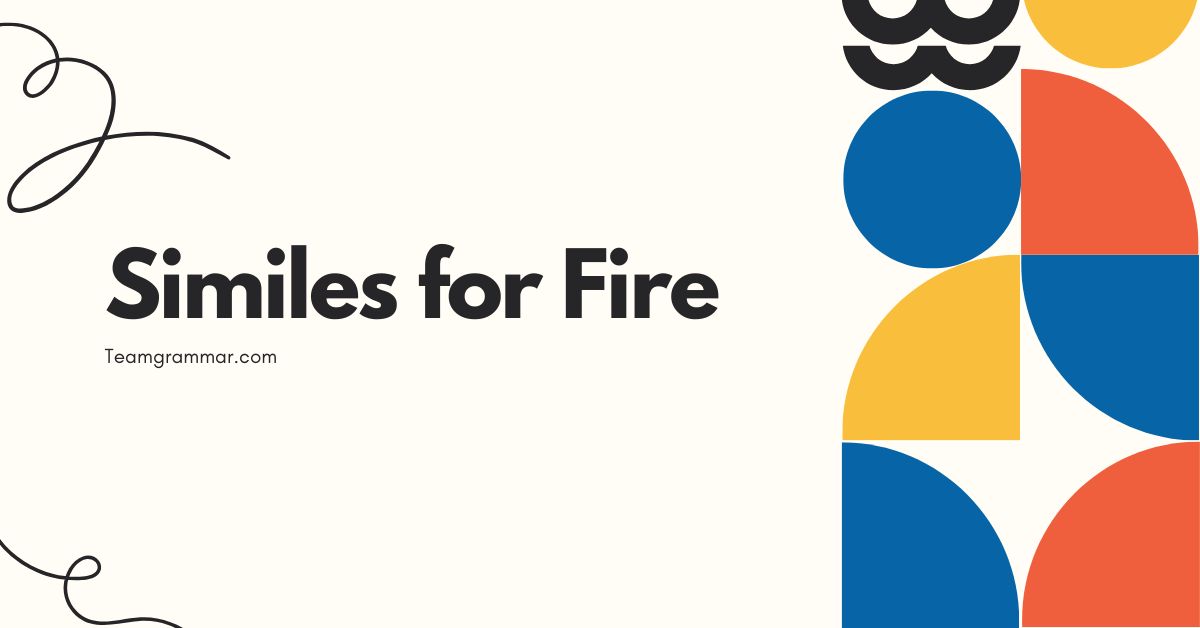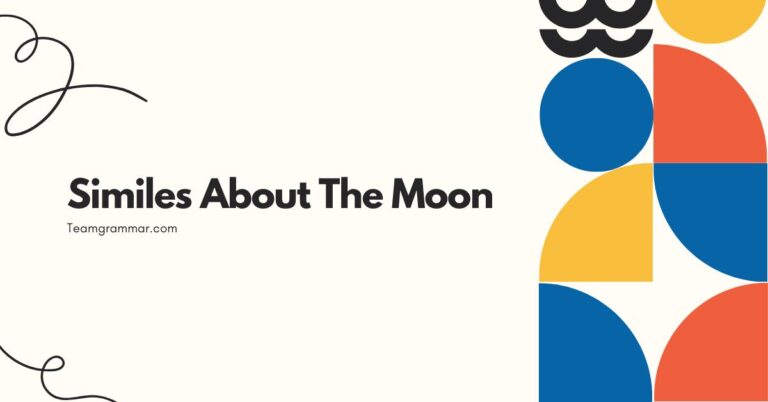35 Similes for Fire: Igniting Your Language Skills
Similes are powerful tools in the English language, allowing us to draw vivid comparisons and enhance our descriptions. Understanding how to use similes effectively, especially when describing intense subjects like fire, can significantly improve your writing and communication skills.
This article delves into the art of crafting similes for fire, exploring various examples, usage rules, and common pitfalls. Whether you’re a student, writer, or language enthusiast, this guide will equip you with the knowledge and practice to master the art of fiery similes.
Table of Contents
- Introduction
- Definition of Simile
- Structural Breakdown of Similes
- Types of Similes
- Examples of Fire Similes
- Usage Rules for Similes
- Common Mistakes with Similes
- Practice Exercises
- Advanced Topics in Similes
- Frequently Asked Questions
- Conclusion
Introduction
Similes are fundamental figures of speech that enrich language by creating comparisons between two unlike things using words such as “like” or “as.” They enable writers and speakers to paint vivid pictures in the minds of their audience, making descriptions more engaging and memorable. Mastering the art of using similes is essential for anyone looking to improve their writing, public speaking, or overall communication skills.
This article focuses specifically on similes related to fire, a powerful and evocative subject that offers a wealth of opportunities for creative comparisons. By understanding the nuances of crafting effective fire similes, you can significantly enhance your ability to express complex ideas and emotions.
Definition of Simile
Asimileis a figure of speech that compares two unlike things using the words “like” or “as.” The purpose of a simile is to create a vivid image or to emphasize a particular quality by drawing a parallel between something familiar and something less so. Unlike a metaphor, which directly equates two things, a simile acknowledges the difference between the two while highlighting their shared characteristics.
Similes are widely used in literature, poetry, and everyday conversation to make language more descriptive and engaging.
Similes function as a type of figurative language, adding depth and color to descriptions. They help to make abstract concepts more concrete and relatable by linking them to tangible experiences.
The effectiveness of a simile depends on the clarity and relevance of the comparison. A well-crafted simile should resonate with the audience and create a strong mental image.
The context in which a simile is used can also affect its interpretation. The surrounding words and phrases can provide additional clues about the intended meaning and emotional tone.
Similes can be used to express a wide range of emotions, from joy and admiration to fear and disgust. They are a versatile tool that can be adapted to suit a variety of writing styles and purposes.
Structural Breakdown of Similes
The basic structure of a simile consists of three key elements: thesubjectbeing described, theconnecting word(“like” or “as”), and theobject of comparison. The subject is the entity that is being characterized, while the object of comparison is something that shares a similar quality or characteristic.
The connecting word serves as the bridge between the two, indicating that a comparison is being made.
Here’s a breakdown of the structural elements:
- Subject: The thing being described (e.g., the fire).
- Connecting Word: “Like” or “as.”
- Object of Comparison: The thing it is being compared to (e.g., a dragon).
For example, in the simile “The fire roared like a dragon,” the subject is “the fire,” the connecting word is “like,” and the object of comparison is “a dragon.” This structure is fundamental to understanding and creating effective similes. The choice of the object of comparison is crucial, as it determines the specific quality or characteristic that is being emphasized.
The order of these elements can sometimes be varied for stylistic effect, but the core structure remains the same. For instance, instead of saying “The fire was like a hungry beast,” one could say “Like a hungry beast, the fire devoured the forest.” The key is to maintain clarity and ensure that the comparison is easily understood.
Types of Similes
Similes can be categorized based on the type of comparison they make. Some similes focus on physical attributes, while others highlight emotional or abstract qualities.
Understanding these different types can help you to choose the most appropriate simile for a given situation.
Descriptive Similes
These similes focus on physical characteristics such as color, size, shape, and texture. For example, “The fire was as red as blood” is a descriptive simile that emphasizes the color of the fire.
Emotional Similes
These similes evoke emotions by comparing the subject to something that elicits a particular feeling. For example, “The fire was like a comforting embrace” suggests warmth and security.
Action Similes
These similes describe the actions or movements of the subject. For example, “The fire danced like a mischievous sprite” emphasizes the erratic and playful movement of the flames.
Abstract Similes
These similes compare the subject to abstract concepts or ideas. For example, “The fire was like a symbol of destruction” highlights the destructive power of the fire.
Examples of Fire Similes
Fire, with its dynamic nature and potent symbolism, is a rich source of inspiration for similes. The following sections provide various examples of fire similes, categorized by the aspect of fire they emphasize.
Similes Based on Color
The color of fire can range from bright yellow and orange to deep red and even blue, depending on the fuel and temperature. Similes based on color can capture the visual intensity of the flames.
The following table provides examples of similes that describe the color of fire:
| Simile | Explanation |
|---|---|
| As red as a ruby | Emphasizes the deep, vibrant red color of the fire. |
| Like molten gold | Highlights the glowing, metallic appearance of the fire. |
| As orange as a sunset | Compares the fire to the warm, vibrant colors of the setting sun. |
| Like a field of poppies | Evokes the bright, intense red of a field of poppies. |
| As yellow as a sunflower | Compares the fire to the cheerful, bright yellow of a sunflower. |
| Like burning embers | Highlights the hot, glowing red color of embers. |
| As crimson as blood | Emphasizes the deep, intense red color, often associated with danger or passion. |
| Like a fox’s fur | Evokes the reddish-orange hue of a fox’s fur. |
| As scarlet as a cardinal | Compares the fire to the bright red color of a cardinal bird. |
| Like a blacksmith’s forge | Highlights the intense, glowing colors seen in a blacksmith’s forge. |
| As blue as a gas flame | Describes the intense blue color of a gas flame, indicating high temperature. |
| Like a sapphire’s gleam | Connects the fire’s blue to the deep and precious shine of a sapphire. |
| As white-hot as a star’s core | Highlights the intense white color of exceptionally hot fire, akin to a star. |
| Like a diamond’s fire | Evokes the brilliant and multifaceted appearance of a fire’s light. |
| As amber as aged whiskey | Describes the warm, golden-brown hue of a fire, similar to aged whiskey. |
| Like a tiger’s eye stone | Compares the fire’s color to the rich, golden-brown tones of a tiger’s eye gem. |
| As golden as a lion’s mane | Highlights the fire’s radiant, golden color, resembling a lion’s mane. |
| Like the glow of a setting sun on copper | Connects the fire’s color to the warm, coppery tones of a sunset. |
| As bronze as an ancient statue | Evokes the earthy, metallic color of a fire, similar to an old bronze statue. |
| Like a blacksmith’s spark | Describes the bright, fiery sparks reminiscent of a blacksmith’s work. |
| As purple as twilight shadows | Compares fire with a subtle purple hue to the shadows of twilight. |
| Like a peacock’s iridescent feather | Highlights the fire’s multicolored shimmer, similar to a peacock feather. |
| As silver as moonlight on ash | Describes the pale, silvery glow of fire reflected on ash. |
| Like a raven’s wing catching light | Connects the dark, shimmering quality of fire to a raven’s wing. |
| As ebony as charred wood | Evokes the deep black color of wood consumed by fire. |
| Like a shadow dancing in the flame | Highlights the interplay of light and dark within the fire itself. |
Similes Based on Intensity
The intensity of fire can range from a gentle warmth to a scorching heat. Similes based on intensity can convey the power and danger of fire.
The following table provides examples of similes that describe the intensity of fire:
| Simile | Explanation |
|---|---|
| As hot as the sun | Emphasizes the extreme heat of the fire. |
| Like a furnace’s breath | Highlights the intense heat emanating from the fire. |
| As fierce as a dragon’s fire | Compares the fire to the legendary fire-breathing dragon. |
| Like the heart of a volcano | Evokes the extreme heat and power of a volcanic eruption. |
| As intense as a burning star | Compares the fire to the intense heat and light of a star. |
| Like a searing iron | Highlights the burning sensation of the fire’s heat. |
| As scorching as desert sands | Emphasizes the dry, intense heat of the fire. |
| Like the forge of Hephaestus | Evokes the powerful heat of the mythical blacksmith’s forge. |
| As fiery as a supernova | Compares the fire to the explosive energy of a supernova. |
| Like a blast furnace’s maw | Highlights the all-consuming heat of a blast furnace. |
| As mild as a candle’s glow | Describes the gentle warmth and low intensity of a small candle flame. |
| Like a summer’s gentle warmth | Compares fire to the comforting heat of a summer day. |
| As tepid as a hearth’s dying embers | Highlights the cooling embers of a fire that is slowly fading. |
| Like a pilot light’s whisper | Evokes the minimal heat and subtle presence of a pilot light. |
| As faint as a distant star | Compares the fire’s intensity to the barely perceptible light of a faraway star. |
| Like the gentle heat of a hand warmer | Describes the mild, comforting warmth of a small hand warmer. |
| As comforting as a bedside lamp | Compares the fire’s low intensity to the soothing light of a lamp. |
| Like the warmth of a sunbeam | Highlights the pleasant and gentle heat of sunlight. |
| As subtle as a match’s first strike | Evokes the moment of minimal heat when a match is first lit. |
| Like the embers of a long-gone fire | Describes the very faint warmth of old, extinguished embers. |
| As intense as a welder’s torch | Emphasizes the concentrated, powerful heat of a welder’s flame. |
| Like the core of a nuclear reactor | Connects the fire’s heat to the immense power of a nuclear reaction. |
| As powerful as lightning striking dry wood | Highlights the sudden, intense heat of lightning igniting a fire. |
| Like the blast of a volcano erupting | Compares the fire’s intensity to the explosive force of a volcanic eruption. |
| As searing as the surface of Mercury | Evokes the extreme heat found on the planet Mercury. |
| Like the forge of a celestial being | Describes the fire with otherworldly, divine intensity. |
Similes Based on Movement
The movement of fire can be fluid, erratic, or even dance-like. Similes based on movement can capture the dynamic nature of flames.
The following table provides examples of similes that describe the movement of fire:
| Simile | Explanation |
|---|---|
| As fluid as water | Emphasizes the flowing, liquid-like movement of the flames. |
| Like a dancing flame | Highlights the erratic, playful movement of the fire. |
| As restless as the sea | Compares the fire to the constant, unpredictable movement of the ocean. |
| Like a whirlwind of fire | Evokes the swirling, chaotic movement of a firestorm. |
| As quick as a striking snake | Compares the fire’s rapid spread to the swiftness of a snake. |
| Like a hungry tongue | Highlights the fire’s licking, consuming motion. |
| As erratic as a hummingbird | Compares the fire’s unpredictable movement to a hummingbird’s flight. |
| Like a swarm of fireflies | Evokes the flickering, dancing movement of many small flames. |
| As graceful as a ribbon dancer | Compares the fire’s movement to the elegant motions of a dancer. |
| Like a river of fire | Highlights the flowing, unstoppable movement of a large fire. |
| As steady as a lighthouse beam | Describes the consistent, unwavering movement of a controlled flame. |
| Like a gentle sway of wheat in the wind | Compares the fire’s movement to the subtle, rhythmic motion of wheat swaying. |
| As calm as a tranquil pool reflecting light | Highlights the smooth, peaceful movement of fire when it’s controlled. |
| Like a slow waltz in the night | Evokes a graceful, unhurried movement of flames in the dark. |
| As subtle as a candle’s flicker | Describes the small, almost imperceptible movement of a candle flame. |
| Like a quiet ripple across water | Compares the fire’s movement to a gentle, spreading ripple. |
| As languid as smoke rising on a still day | Highlights the slow, relaxed movement of smoke from a fire. |
| Like a soft breeze through curtains | Evokes the gentle, flowing movement of flames in a controlled environment. |
| As deliberate as a controlled burn | Describes the precise, intentional movement of a managed fire. |
| Like a careful brushstroke on canvas | Compares the fire’s controlled spread to an artist’s delicate touch. |
| As chaotic as a storm surge | Emphasizes the wild, unpredictable movement of a raging fire. |
| Like a runaway train careening downhill | Connects the fire’s movement to an unstoppable, dangerous force. |
| As frenzied as a flock of startled birds | Highlights the erratic, panicked movement of flames spreading rapidly. |
| Like a tempest unleashed from its cage | Compares the fire’s movement to a violent storm breaking free. |
| As unpredictable as a shattered mirror’s reflection | Evokes the fragmented, chaotic movement of flames spreading unevenly. |
| Like a wildfire consuming dry grass | Describes the rapid, destructive movement of a fire in dry conditions. |
Similes Based on Sound
Fire is often accompanied by distinct sounds, such as crackling, roaring, and hissing. Similes based on sound can add an auditory dimension to the description of fire.
The following table provides examples of similes that describe the sound of fire:
| Simile | Explanation |
|---|---|
| Like a crackling symphony | Highlights the complex, rhythmic sounds of the fire. |
| As loud as a roaring beast | Compares the fire to the powerful roar of an animal. |
| Like the hiss of a serpent | Evokes the dangerous, threatening sound of the fire. |
| As sharp as a whip crack | Compares the fire’s sound to the sudden, piercing crack of a whip. |
| Like the whisper of dry leaves | Highlights the subtle, rustling sounds of the fire. |
| As soft as a sigh in the wind | Describes the gentle, almost inaudible sound of a small flame. |
| Like the rustle of silk in the dark | Compares the fire’s sound to the quiet, luxurious rustling of silk. |
| As muted as a heartbeat in the night | Highlights the subtle, rhythmic sound of a controlled fire. |
| Like the murmur of a distant stream | Evokes the peaceful, calming sound of a small, contained fire. |
| As hushed as a secret being told | Describes the quiet, intimate sound of a flickering flame. |
| As deafening as a thunderclap | Emphasizes the loud, overwhelming sound of a large fire. |
| Like the roar of a crashing wave | Compares the fire’s sound to the powerful crash of ocean waves. |
| As piercing as a siren’s wail | Highlights the sharp, alarming sound of a fire’s crackling. |
| Like the scream of metal being torn | Evokes the harsh, destructive sound of fire consuming metal. |
| As booming as a cannon’s blast | Describes the loud, explosive sound of a fire igniting rapidly. |
| Like the grinding of tectonic plates | Compares the fire’s sound to the immense power of geological forces. |
| As jarring as a sudden earthquake | Highlights the disruptive, unsettling sound of a fire’s intensity. |
| Like the bellow of a mythical beast | Evokes the terrifying, primal sound of a raging fire. |
| As resonant as a cathedral’s organ | Describes the deep, echoing sound of a large fire burning. |
| Like the shattering of glass in a storm | Compares the fire’s sharp sounds to the destructive force of a storm. |
Similes Based on Destructive Power
Fire is a powerful force that can cause widespread destruction. Similes based on destructive power can convey the danger and devastation associated with fire.
The following table provides examples of similes that describe the destructive power of fire:
| Simile | Explanation |
|---|---|
| Like a ravaging beast | Emphasizes the destructive, all-consuming nature of the fire. |
| As destructive as a hurricane | Compares the fire to the destructive force of a hurricane. |
| Like a swarm of locusts | Evokes the image of a fire consuming everything in its path. |
| As relentless as a flood | Compares the fire to the unstoppable force of a flood. |
| Like a plague sweeping through a city | Highlights the widespread devastation caused by the fire. |
| As unforgiving as time | Describes the fire’s inevitable, destructive effects. |
| Like a demon unleashed from hell | Evokes the image of a malevolent force wreaking havoc. |
| As catastrophic as an earthquake | Compares the fire to the devastating impact of an earthquake. |
| Like a raging inferno | Highlights the intense, uncontrollable nature of the fire. |
| As devastating as a nuclear blast | Compares the fire to the ultimate destructive power of a nuclear explosion. |
| As subtle as a creeping mold | Describes the slow, insidious destruction caused by a small fire. |
| Like a silent erosion wearing away stone | Compares the fire’s destructive power to the gradual decay of stone. |
| As stealthy as a thief in the night | Highlights the hidden, deceptive nature of a fire’s potential damage. |
| Like a slow poison spreading through a system | Evokes the gradual, harmful effects of a fire over time. |
| As corrosive as acid on metal | Compares the fire’s destructive power to the corrosive effects of acid. |
| Like a gradual decay of a once-great empire | Describes the long-term, irreversible impact of fire on structures. |
| As undermining as termites in wood | Highlights the hidden, structural damage caused by fire. |
| Like a slow leak draining a reservoir | Evokes the gradual depletion of resources due to a fire. |
| As subtle as a crack widening over years | Compares the fire’s destructive power to the slow progression of structural damage. |
| As insidious as rust on iron | Emphasizes the persistent, corrosive effects of fire over time. |
| As swift as a scythe through wheat | Highlights the quick and efficient devastation caused by a wildfire. |
| Like a tornado ripping through farmland | Compares the fire’s destructive path to the chaotic damage of a tornado. |
| As thorough as a forest fire after a drought | Describes the complete and utter destruction left in the wake of a drought-fueled fire. |
| Like a sandstorm burying an ancient city | Evokes the image of a fire engulfing and obliterating everything in its path. |
| As complete as a demolition crew’s work | Compares the fire’s destructive power to the intentional destruction of a building. |
| Like a flood wiping away settlements | Highlights the devastating, life-altering impact of a large fire. |
Usage Rules for Similes
Using similes effectively requires adherence to certain rules. These rules ensure that the comparison is clear, relevant, and impactful.
- Clarity: The comparison should be easily understood by the audience. Avoid obscure or overly complex references.
- Relevance: The object of comparison should share a meaningful characteristic with the subject. A random or illogical comparison will weaken the simile.
- Originality: While common similes can be effective, strive for originality to make your writing more engaging and memorable.
- Context: Consider the context in which the simile is used. The surrounding words and phrases should support the comparison and enhance its impact.
Avoid cliches: Overused similes, such as “as red as a rose,” can lose their impact. Try to come up with fresh and original comparisons.
Be specific: The more specific the comparison, the more vivid the image will be. For example, instead of saying “The fire was like a light,” say “The fire was like a beacon in the darkness.”
Use sparingly: Overusing similes can make your writing feel forced and unnatural. Use them judiciously to enhance your descriptions, but don’t rely on them too heavily.
Common Mistakes with Similes
Several common mistakes can undermine the effectiveness of similes. Being aware of these pitfalls can help you to avoid them and craft more compelling comparisons.
Incorrect Comparison: Comparing things that have no logical connection.
- Incorrect: The fire was like a refrigerator.
- Correct: The fire was like a furnace.
Using Metaphors Instead of Similes: Forgetting to use “like” or “as.”
- Incorrect: The fire was a hungry beast. (This is a metaphor)
- Correct: The fire was like a hungry beast. (This is a simile)
Overusing Cliches: Relying on tired, unoriginal comparisons.
- Cliche: As hot as hell.
- Improved: As hot as the core of a star.
Lack of Clarity: Using comparisons that are confusing or obscure.
- Unclear: The fire was like a quibble.
- Clear: The fire was like an argument, quickly escalating out of control.
Practice Exercises
The following exercises will help you practice creating and identifying effective similes for fire.
Exercise 1: Identifying Similes
Identify the similes in the following sentences:
| Question | Answer |
|---|---|
| 1. The fire danced like a mischievous imp. | danced like a mischievous imp |
| 2. The flames were as red as rubies. | as red as rubies |
| 3. The fire’s roar was deafening. | (No simile present – this is a statement of fact) |
| 4. The smoke rose like a ghostly apparition. | rose like a ghostly apparition |
| 5. The fire was as hot as the sun. | as hot as the sun |
| 6. The burning wood crackled and popped. | (No simile present – this is a description of sound) |
| 7. The wildfire spread like a ravenous beast devouring the forest. | spread like a ravenous beast devouring the forest |
| 8. The embers glowed like the eyes of a predator in the night. | glowed like the eyes of a predator in the night |
| 9. The firefighter battled the blaze with unwavering determination. | (No simile present – this describes an action) |
| 10. The heat radiated from the fire as intense as a desert sun. | as intense as a desert sun |
Exercise 2: Completing Similes
Complete the following similes by adding an appropriate object of comparison:
| Question | Answer |
|---|---|
| 1. The fire was as bright as _____. | The fire was as bright as a supernova. |
| 2. The flames moved like _____. | The flames moved like dancing ribbons. |
| 3. The heat from the fire felt like _____. | The heat from the fire felt like a furnace’s breath. |
| 4. The crackling sound was like _____. | The crackling sound was like a symphony of destruction. |
| 5. The fire consumed the forest like _____. | The fire consumed the forest like a hungry dragon. |
| 6. The embers glowed as red as _____. | The embers glowed as red as molten lava. |
| 7. The smoke billowed upwards, looking like _____. | The smoke billowed upwards, looking like a ghostly shroud. |
| 8. The fire’s intensity was as fierce as _____. | The fire’s intensity was as fierce as a dragon’s rage. |
| 9. The burning building collapsed like _____. | The burning building collapsed like a house of cards. |
| 10. The fire spread quickly, like _____. | The fire spread quickly, like a rumor through a crowd. |
Exercise 3: Creating Similes
Create your own similes to describe the following aspects of fire:
| Aspect of Fire | Example Simile |
|---|---|
| 1. The color of the flames | The flames were as orange as a ripe pumpkin. |
| 2. The heat of the fire | The heat of the fire was like standing in front of an open oven. |
| 3. The sound of the fire | The sound of the fire was like the snapping of a thousand twigs. |
| 4. The movement of the flames | The flames danced like a troupe of playful performers. |
| 5. The destructive power of the fire | The destructive power of the fire was like a giant eraser wiping away everything in its path. |
| 6. The embers left behind | The embers glowed with a faint light, like dying stars. |
| 7. The smell of the smoke | The smell of the smoke hung heavy in the air, like a burnt offering. |
| 8. The feeling of being near a fire | Being near the fire was like receiving a warm embrace on a cold day. |
| 9. A controlled campfire | The controlled campfire burned steadily, like a faithful guardian. |
| 10. An out-of-control wildfire | The out-of
control wildfire raged, like an unchained beast. |
Advanced Topics in Similes
Once you’ve mastered the basics of simile construction, you can explore more advanced techniques to add depth and nuance to your writing. These techniques involve layering similes, using extended similes, and combining similes with other figures of speech.
Layered Similes
Layered similes involve using multiple similes in succession to create a more complex and detailed image. For example:
In this example, three similes are used to describe the fire, each adding a different layer of detail and emotion.
Extended Similes
An extended simile is a simile that is developed over several sentences or even paragraphs. This allows you to explore the comparison in greater depth and create a more vivid and memorable image.
This extended simile traces the development of the fire from a small spark to a raging inferno, using a series of comparisons to highlight its growth and power.
Combining Similes with Other Figures of Speech
Similes can be combined with other figures of speech, such as metaphors, personification, and hyperbole, to create even more complex and evocative descriptions.
By combining these different figures of speech, you can create a rich and multi-layered description that engages the reader on multiple levels.
Frequently Asked Questions
Conclusion
Mastering the art of crafting similes for fire can significantly enhance your writing and communication skills. By understanding the structure, types, and usage rules of similes, you can create vivid and memorable descriptions that engage your audience and bring your words to life.
Remember to practice regularly, experiment with different comparisons, and strive for originality to develop your own unique style. With dedication and creativity, you can harness the power of similes to ignite your language skills and express yourself with greater clarity and impact.







